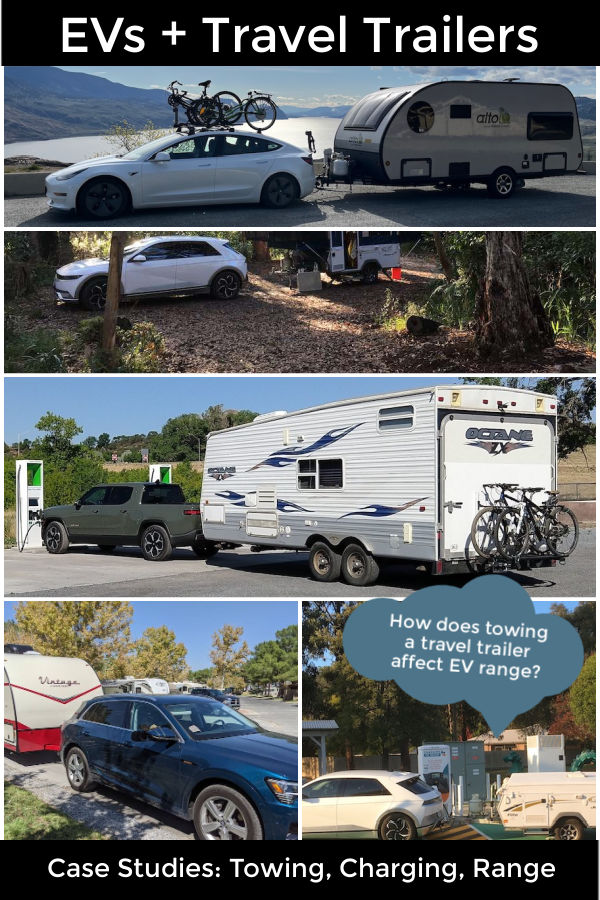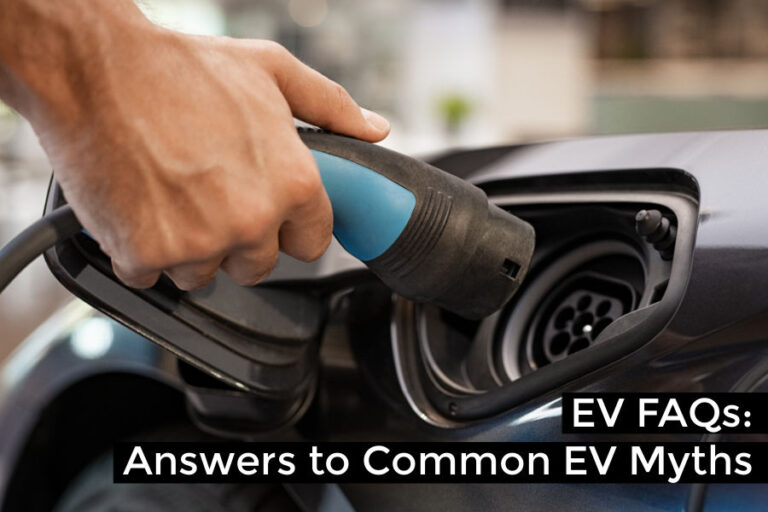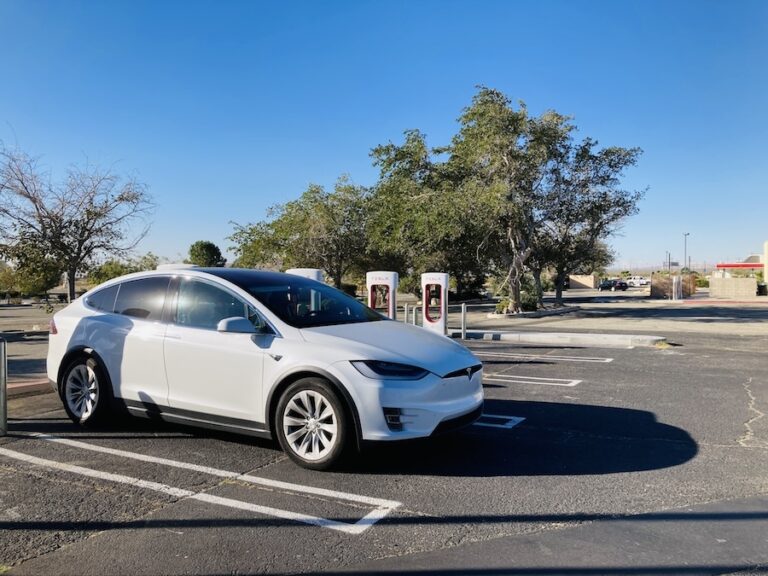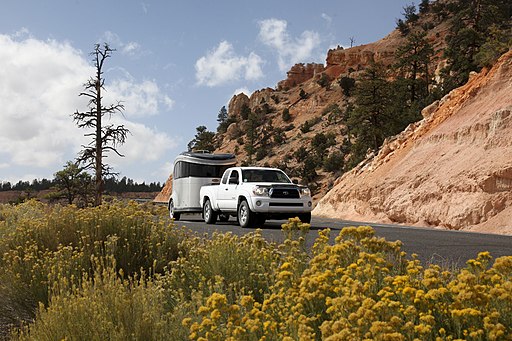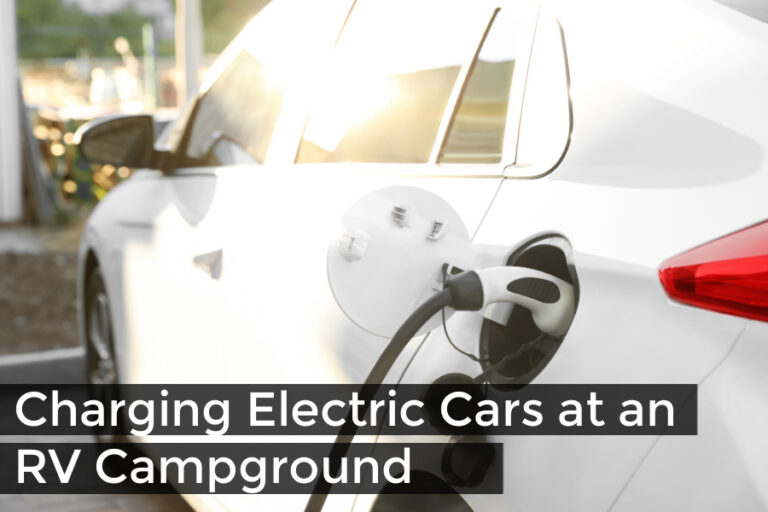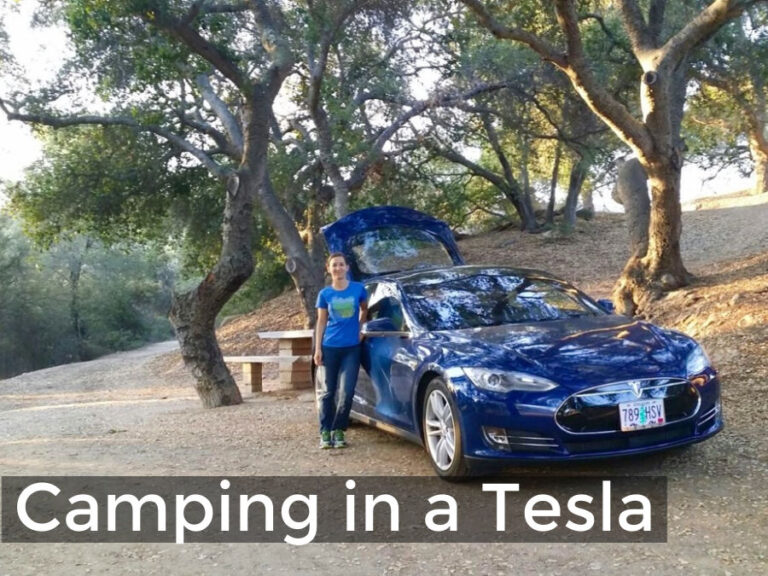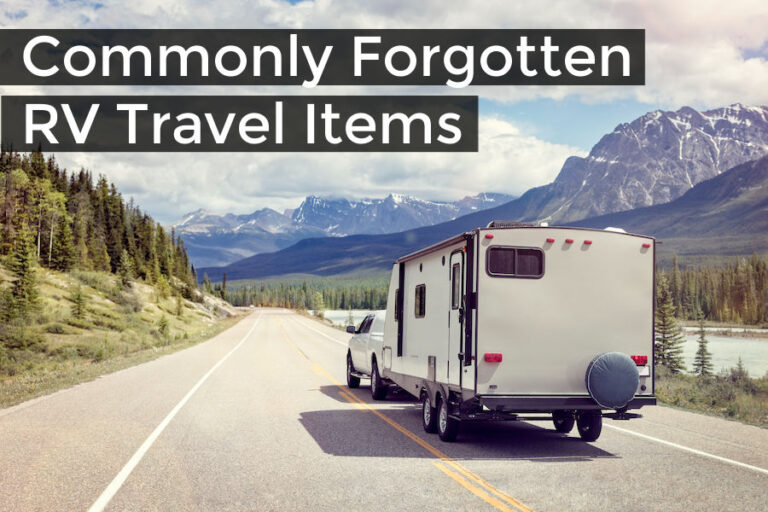How does towing a travel trailer affect EV range?
We’ve asked the EV Camping + Travel community what are the biggest questions and concerns about camping and traveling with electric vehicles.
More than anything, people are wondering how towing a trailer affects range on an EV. The viability of a camping road trip hinges on whether towing affects EV range too much and how often you’d need to stop to charge.
To learn more about towing a trailer with an electric car, specifically for camp trailer road trips, we did some research. In this post, we’ll share what we learned from EV owners who already tow travel trailers about their towing experiences and tips.
Can you tow with an electric vehicle?
The short answer is yes, electric cars can tow trailers. As you’ll see in our case studies below, many EV owners report that towing is a breeze.
However, even vehicles advertised to have a towing capacity or an option to add a tow hitch, like the Nissan Leaf or Chevy Bolt, have been discouraged from towing by the car manufacturers.
In case you’re wondering the reverse: Can you tow an EV? The answer is (usually) no.
Without a transmission, putting an EV in Neutral while being pulled by another vehicle does not work. Most electric motors generate power whenever the wheels are spinning, so it can be dangerous to tow if the EV’s wheels are touching the ground.
There are exceptions: EVs can be towed on a flatbed trailer. And as a reader pointed out, you can tow 2 wheel drive EVs on a partial trailer that keeps the front wheels off the ground. In this case, it may be necessary to disconnect the 12V battery to ensure the automatic parking brake doesn’t apply itself.
How does towing affect EV range?
The amount of range that is affected when an electric vehicle is towing a travel trailer will vary depending on:
- the weight of the trailer
- the aerodynamic drag of the trailer
- the efficiency of the electric vehicle
However, in general, towing a travel trailer can reduce the range of an electric vehicle by up to 50%.
For example, the Tesla Model Y Long Range has an EPA-estimated range of 330 miles. However, towing a 5,000-pound travel trailer can reduce the range to as low as 165 miles.
The Rivian R1T has an EPA-estimated range of 314 miles. However, towing a 7,500-pound travel trailer can reduce the range to as low as 157 miles.
Improving EV range while towing
There are a few things that you can do to help improve the range of your electric vehicle when towing a travel trailer.
First, make sure that the trailer is properly loaded. An unevenly loaded trailer can create more drag and reduce the range.
Second, slow down when driving. The faster you drive, the more energy you will use.
Finally, plan your trips carefully. Be aware of uphill parts of the drive which will use up more charge and reduce range. Make sure that you have plenty of charging stations along your route.
By following these tips, you can help to improve the range of your electric vehicle when towing a travel trailer.
Real Use Case Studies: EVs Towing Trailers
We interviewed some folks in the EV Camping community about their experiences towing a trailer with EVs. Their insights provide valuable information on range, charging, towing experience, and tips for off-grid adventures.
Here are their case studies.
Rivian Electric Truck: Towing and Camping
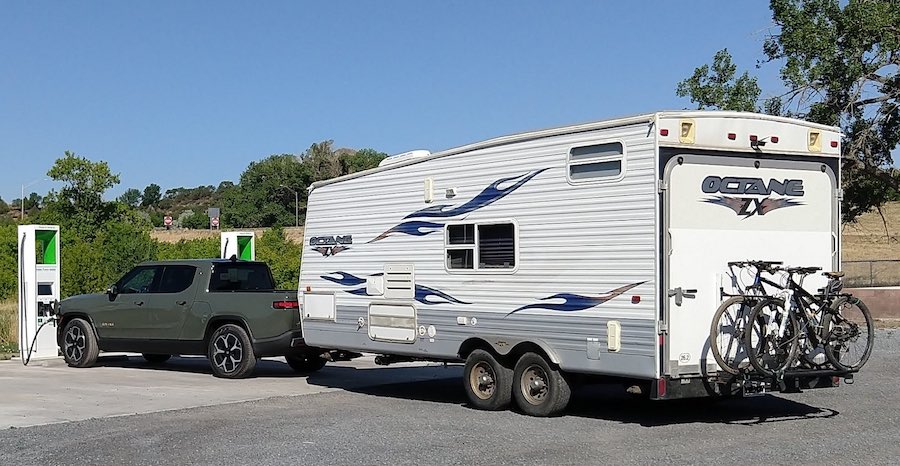
Marcy and John Beard of allelectricproject.com are a nomadic couple we met a few years ago at the RV Entrepreneur Summit. John has expertise in installing solar and even built a solar + battery set up for their travel trailer.
The Beards recently got a Rivian R1T Launch Edition truck with a large pack battery and 21″ wheels. They retrofitted their “Home on Wheels”, a Jayco Octane toy hauler weighing around 8,000-8,500 pounds, to use only electricity instead of propane.
Towing the toy hauler trailer with the Rivian R1T reduces the range approximately in half.
While efficiency without the trailer is typically just over 2 miles/kWh, while towing, they see anywhere from 1 to 1.5 mi/kWh. Variation depends on elevation changes, wind speed/direction, temperature, and driving speed.
Marcy and John plan for up to 100 miles between charging to stay on the safe side. “Overall, we drive fewer daily miles and it takes more planning than it used to.”
As with previous cases studies, the couple describes the towing experience as super easy. “We hardly know there’s a trailer behind us,” they say.
The truck’s powerful acceleration and stable handling contribute to a comfortable towing experience.
Rivian Charging With A Camp Trailer
The Rivian R1T’s cameras and adjustable truck height assist with easy hooking up.
However, they admit that accessing charging stations can be a challenge, as most are not designed for trailers. Unhooking and re-hooking are skills they have developed to accommodate charging station limitations.
Marcy and John utilize campground facilities with 50A hookups and make use of the level 1/level 2 charger that came with the Rivian truck.
They emphasize the need to plan charging time. The Beards stop at fast chargers at least once a day between campgrounds, which again, often requires unhitching the trailer. On the plus side, the trailer makes a very comfortable, air-conditioned space to wait while charging.
While towing, it sometimes takes over an hour in order to get closer to 100% charge, when they want to be sure they’ll have the fullest capacity on the road. On a level 2 charger, fully recharging can take more than one overnight stay.
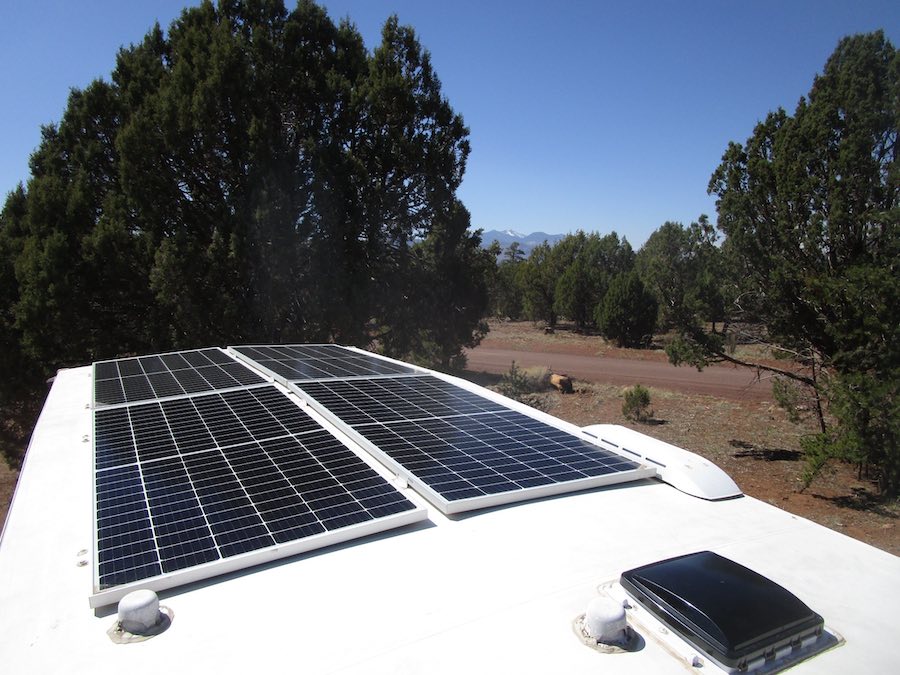
“We do charge from our trailer solar, but it’s only as a means to draw down our trailer battery because we typically have way more incoming solar energy than we can use (except in the middle of winter). It provides a tiny fraction of the energy needed for the truck. But hey, every kWh from solar is that much less we’re paying to the EV charging companies. It’s also a last-ditch backup plan if we ever got down to the last bit of battery energy, although it’s unlikely to ever make a real difference.”
The Beards are experienced boondockers, having spent 198 days straight without connecting to shore power (sometimes dry camping, other times connected to water/sewer at RV parks). But that was before they switched to towing with an EV.
Boondocking for them now means staying reasonably close to a fast charger so they can keep the Rivian charged up. They plan their travel around the fast charger network, using a base camp for the trailer and taking longer trips with the truck only.
EV Camping Advice
The couple shared these words of advice with us: “For anyone considering doing this, I’d suggest looking at it as early adoption, a big adventure, a test case, and a way to highlight the challenges and things that need to be done to make it easier for everyone else down the proverbial road. It has changed how we travel, and in our case it’s worth it, but it’s not (yet) for everyone.”
Tesla Model 3: Towing Range, Power and Practicality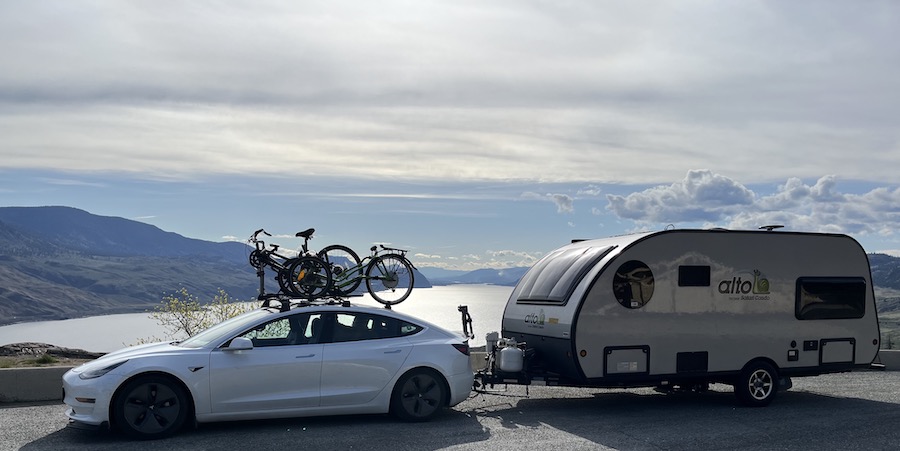
One EV owner, VJ, who drives a Tesla Model 3 Dual-Motor EV, tows a Safari Condo Alto 2114 weighing 3,000 pounds. He uses a custom reinforced hitch receiver to allow the use of a weight distribution hitch for towing.
Towing the Safari Condo travel trailer significantly impacts the EV’s range, reducing range to at least half, and sometimes even less, especially in cold weather, headwinds, or when driving at the speed limit. The energy consumption while towing ranges from 350 Wh/km to over 500 Wh/km.
Despite the reduced range, this owner finds towing with their Tesla Model 3 Dual relatively easy. They highlight the benefits of regenerative braking, which virtually eliminates the need to apply brakes on long, steep downhill grades.
Uphill towing is also manageable, making it a smooth experience overall.
Tesla Model 3 Charging With Trailer
 Charging the EV during a typical session involves spending a maximum of 50 minutes at a Tesla supercharger. For generic chargers, the charging time can range from 2 to 4+ hours.
Charging the EV during a typical session involves spending a maximum of 50 minutes at a Tesla supercharger. For generic chargers, the charging time can range from 2 to 4+ hours.
Occasionally, VJ needs to unhitch the trailer to back into a charging stall, as not all charging stations are designed to accommodate trailers.
Tesla Off Grid and Tips
When it comes to off-grid or boondocking experiences, this owner shares that charging an EV using portable solar panels is entirely impractical. They recommend carrying a generator as an emergency backup, but they haven’t needed to use it yet.
Additionally, they advise having all the necessary charging adapters, monitoring energy consumption, and allowing a margin of 10-20% range on arrival to ensure a smooth journey.
2019 Audi e-tron 55 Towing: Comfortable with Planning

Paul K, owner of a 2019 Audi e-tron 55, shares his experience towing a Gulfstream Vintage Cruiser 19CSK weighing 3,400 pounds.
With the Gulfstream travel trailer in tow, the EV’s range drops to approximately 110 miles from the unladen highway range of 220 miles. Paul plans their charging stops accordingly, considering a realistic range of about 95 miles between charging stations.
Towing with the Audi e-tron 55 is described as a “sublime” experience. The EV’s instant and massive torque make accelerating easy, while the heavy and balanced center of gravity ensures stability and a comfortable ride. Sway is not a concern for this owner.
However, he does mention that lack of pull-through charging at stations can be a hassle. To avoid unhitching frequently, Paul carefully chooses charging stations with wide parking lanes.
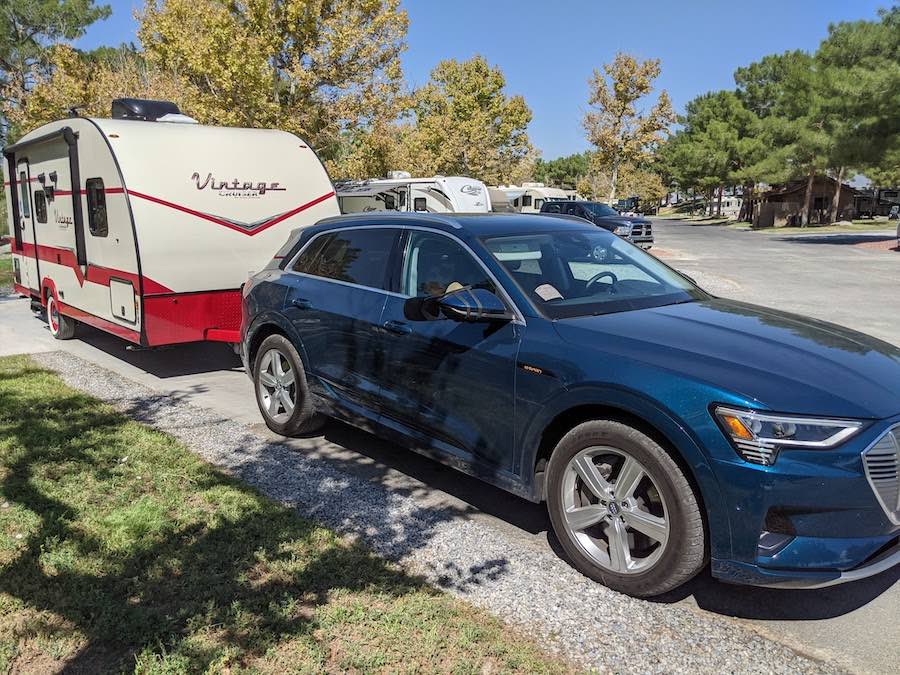
Audi E-Tron Charging
Charging sessions typically involve arriving at a charger with a State of Charge (SoC) between 10-30% and charging up to 80-90% SoC. The Audi e-tron 55 has a flat 150kWh charge curve from 0% to 80%, simplifying the charging strategy.
At a fast charger, it takes around 20-30 minutes to reach 80% capacity and 30-40 minutes to go beyond 90%.
EV Camping Charge Tips
Paul says that off-grid / solar charging the EV battery is not practical.
“A typical RV solar array on a single-axle trailer towable by an EV might deliver 500 watts on a typical day. It would take a week or more of charging to get back to 80% — and you can only charge during the day, and still need to use some of that energy for the trailer.”
While Paul doesn’t boondock, he shared this charging hack for RV parks without 50 amp service:
“In those cases I use a TT-30P to 2x 5-20R splitter and plug the trailer into one side and an L1 charger into the other side. The L1 charger can run at 16 amps, which is enough to fully charge the car in around 2 days. At nicer RV parks with 50 amp service, the trailer plugs into the TT-30 plug and the car’s L2 charger goes into the 14-50, and I can fully charge overnight.”
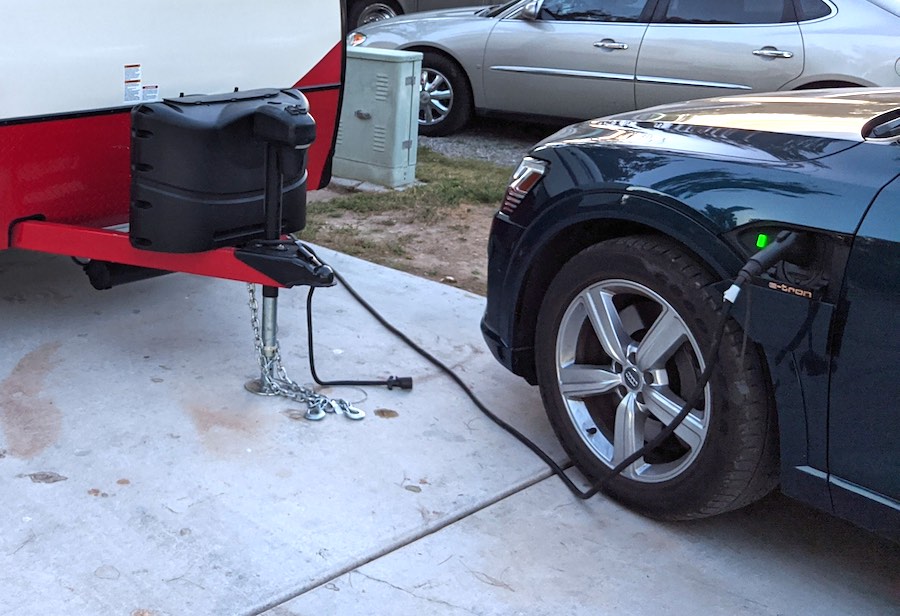
2023 Hyundai Ioniq 5 Towing and Travel
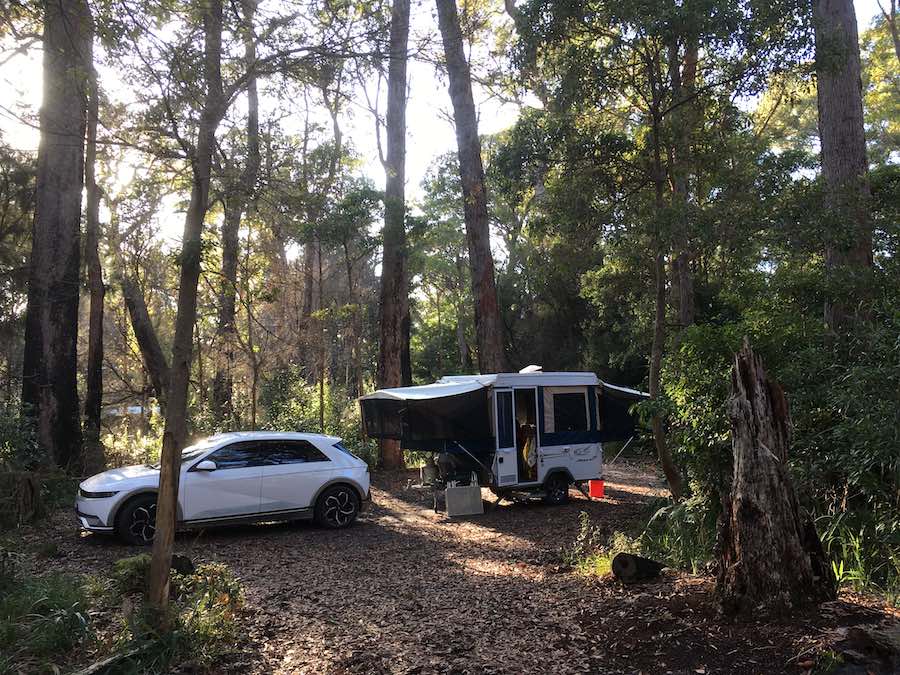
Peter, Australian owner of a 2023 Hyundai Ioniq 5 and previously a 2019 Hyundai Kona EV (not approved to tow), shared his experience towing a 2010 Jayco Flite wind-up camper weighing approximately 850 kg (1874 lbs).
Towing the camper with the Ioniq 5 reduces the range by about a third, from over 400 km to just under 300 km (186 miles). The Ioniq 5 averages around 26.5 kWh/100 km (around 2.5 mi/kWh) while towing.
According to Peter, both vehicles (Ioniq 5 and Kona) tow very easily. The Ioniq 5 is especially easy to tow.
Camping and EV Charging With Trailer
The main challenge towing his trailer is the lack of tow-through at fast DC chargers, which sometimes requires approaching at odd angles or unhitching. However, Peter mentions that unhitching is not a big hassle.
Peter likes to book a powered site at campgrounds and trickle charge the car from the camper’s 230V/10A outlet. They pause charging during meal preparation.
Peter notes: “Our Ioniq 5 has a 230VAC/15A vehicle to load output, which replicates the supply at a standard powered campsite. So, we can use the car’s battery to top up the camper’s internal 12V battery and run mains electric appliances. We camped off grid with the Kona and used just the camper’s 12V and gas during a 4 day stay without needing input from the car.”
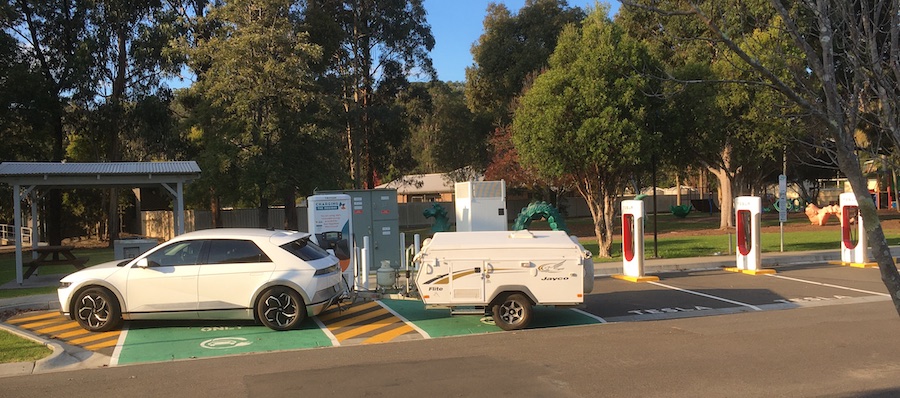
EV Trailer-Travel Tips
As for tips, Peter recommends using cruise control to maintain a steady speed on highways, which allows for regenerative braking on downhills without activating the trailer brakes and wasting energy.
He advises sticking to 90 km/h (55 mph) for better range, as there is less wind resistance compared to higher speeds. He cautions against towing above 100 km/h (about 62 mph).
We hope these case studies help you understand how does towing affect EV range with camping and travel trailers. Towing with an EV can only get better in the future.
Do you have an EV towing a travel trailer? Please reach out and share your story with us!
Like this post? Pin it for later or share with friends!
